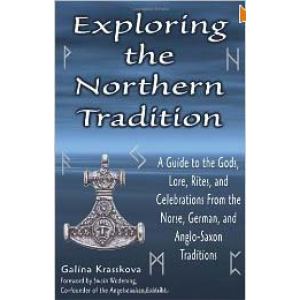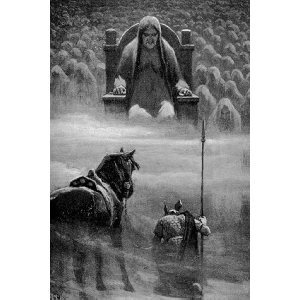
Book: Exploring The Northern Tradition by Galina Krasskova
Exploring the
Northern Tradition is an overview of the modern reconstruction of the ancient religion of the Germanic and Scandinavian peoples. This religion, called Heathenry, is one of the fastest growing polytheistic religious movements in the United States today with over forty thousand adherents. This book provides a thorough guide to the cosmology, values, ethics, and rituals practiced by modern Heathens.
Readers will have the opportunity to explore the sacred stories of the various Heathen Gods like Odin, Frigga, Freya, and Thor and will be granted a look into the devotional practices of modern votaries. The most common devotional rite: the faining or blot is examined in rich detail with examples given for personal use. Additionally, readers are introduced to the concept of wyrd or fate, so integral to the Heathen worldview.
Unlike many books on Heathenry, Exploring the Northern Tradition is not denomination specific, nor does it seek to overwhelm the reader with unfamiliar Anglo-Saxon or Norse terminology. For those new to Heathenry, Pagans who wish to learn more about the Norse Deities, or those simply interested in learning about this unique religion, this book is the perfect introduction.
There was a time when all of Northern Europe followed a common faith. The people shared a belief in the same Gods, common ethics and common values. A small portion of these beliefs and values have been passed down to us in the Eddas, Sagas and other history. In modern times there are those who still follow the old ways. All modern Heathens (those who follow the Northern Tradition) share a common theology, a common set of core values and a common documented history going back 1000+ years.
In Exploring The Northern Tradition, Galina Krasskova has captured the essence of this theology, values and history in a book that is both highly informative and at the same time enjoyable to just sit and read.
After a brief look at the history of the Northern Tradition, Galina Krasskova introduces us to what might be considered the three major branches of modern Heathenry: the Tribalist, the Universalist, and the Folkish Heathen. We are then introduced to the Theodish Belief ~ a form of Tribal Heathenry, bound together by a "web-of-oaths". Here we see tribal bonds formed between men of varying social status by means of sacred oaths. It is also pointed out that while all Theods are Tribalists, not all Tribalists hold fast to the Theodish Belief.
Galina Krasskova next introduces us to the Cosmology of the Northern Tradition. From Ginungagap to Yggdrasil; and each of the nine worlds, from Midgard to Asgard, to Helheim. We learn the structure of the Universe as it is understood by those who follow the Northern Tradition.
As we continue Exploring The Northern Tradition, Galina Krasskova introduces us to the
Gods and goddesses of our ancestors, of our blood and of the Northern People. But here we have much more than a list of the Gods. For each of the
Gods and Goddesses we are offered an invocation as well as their history and stories of their deeds. Consisting of about one-third of the book, this section gives the reader the opportunity to know the Gods and Goddesses that still call to us, even today.
After meeting the Gods of our ancestors we are introduced to concepts unique to the Northern Tradition. Galina Krasskova explains the concept of Wyrd and the Soul Matrix. Heathern ethics and values are explained, giving us an introduction to the Nine Noble Virtues and the 12 AEtheling Thews.
Finally, Exploring The Northern Tradition closes with chapters on the Blot, Symbel, and Personal Devotions.
I found Exploring The Northern Tradition to be well-written, properly researched, informative and enjoyable to read. If you have never experienced the Northern Tradition, here is a guide to let you begin your exploration. If you set sail toward the Northern Star many years ago, Exploring The Northern Tradition will be a reminder of old friends, of the call of the Gods and of the honor and virtues of the people of the Northern Lands.
Galina Krasskova draws on her own 12 years of experience as a Heathen priest. She is currently Aeweweard in Thaet Angelseaxisce Ealdriht, a member of The Troth, and has also studied interfaith ministry in NYC. Galina cofounded the New York Metro Asatru Society in October of 2000. She is a frequent contributor to such respected Pagan and Heathen magazines as Sagewoman, New Witch, Idunna, The Ealdriht Boc, and Marklander.
Highly Recommended !
Buy Galina Krasskova's book: Exploring The Northern TraditionFree eBooks (Can Be Downloaded):
Marcus Cordey - Magical Theory And TraditionEleanor Hull - The Northmen In BritainThe Troth - Welcome To The Troth Honoring The Northern Tradition
 Isa translates as “ice” and the interpretations of this Rune are almost always negative. Whenever one's blocked in life, whether it's an emotional, sexual or even a financial block, it's ruled by the force contained in Isa. Therefore, Isa is the state of stagnation and one's inability to move psychologically, which often causes sadness and depression. One needs lots of strength to overcome Isa, which is evident from the physical characteristics of ice. Isa's action prevents any possible movement, be it phychological or physical; it also blocks the action of other Runes which are opened with Isa in divination. This Rune is also connected to the Ego which can be the source of stagnation. Isa is actually a representation of a frozen state in which hides the germ of life. A mind in the state of stagnation actually hides within itself the possibility of spiritual progress, possibilities that can be accomplished with extraordinary effort, but is in no way unattainable. Regardless of its alleged negativity, Isa can be a very useful Rune. As a magical image it's used to stop some processes as well as to stabilize a current state of affairs.
Isa translates as “ice” and the interpretations of this Rune are almost always negative. Whenever one's blocked in life, whether it's an emotional, sexual or even a financial block, it's ruled by the force contained in Isa. Therefore, Isa is the state of stagnation and one's inability to move psychologically, which often causes sadness and depression. One needs lots of strength to overcome Isa, which is evident from the physical characteristics of ice. Isa's action prevents any possible movement, be it phychological or physical; it also blocks the action of other Runes which are opened with Isa in divination. This Rune is also connected to the Ego which can be the source of stagnation. Isa is actually a representation of a frozen state in which hides the germ of life. A mind in the state of stagnation actually hides within itself the possibility of spiritual progress, possibilities that can be accomplished with extraordinary effort, but is in no way unattainable. Regardless of its alleged negativity, Isa can be a very useful Rune. As a magical image it's used to stop some processes as well as to stabilize a current state of affairs.



